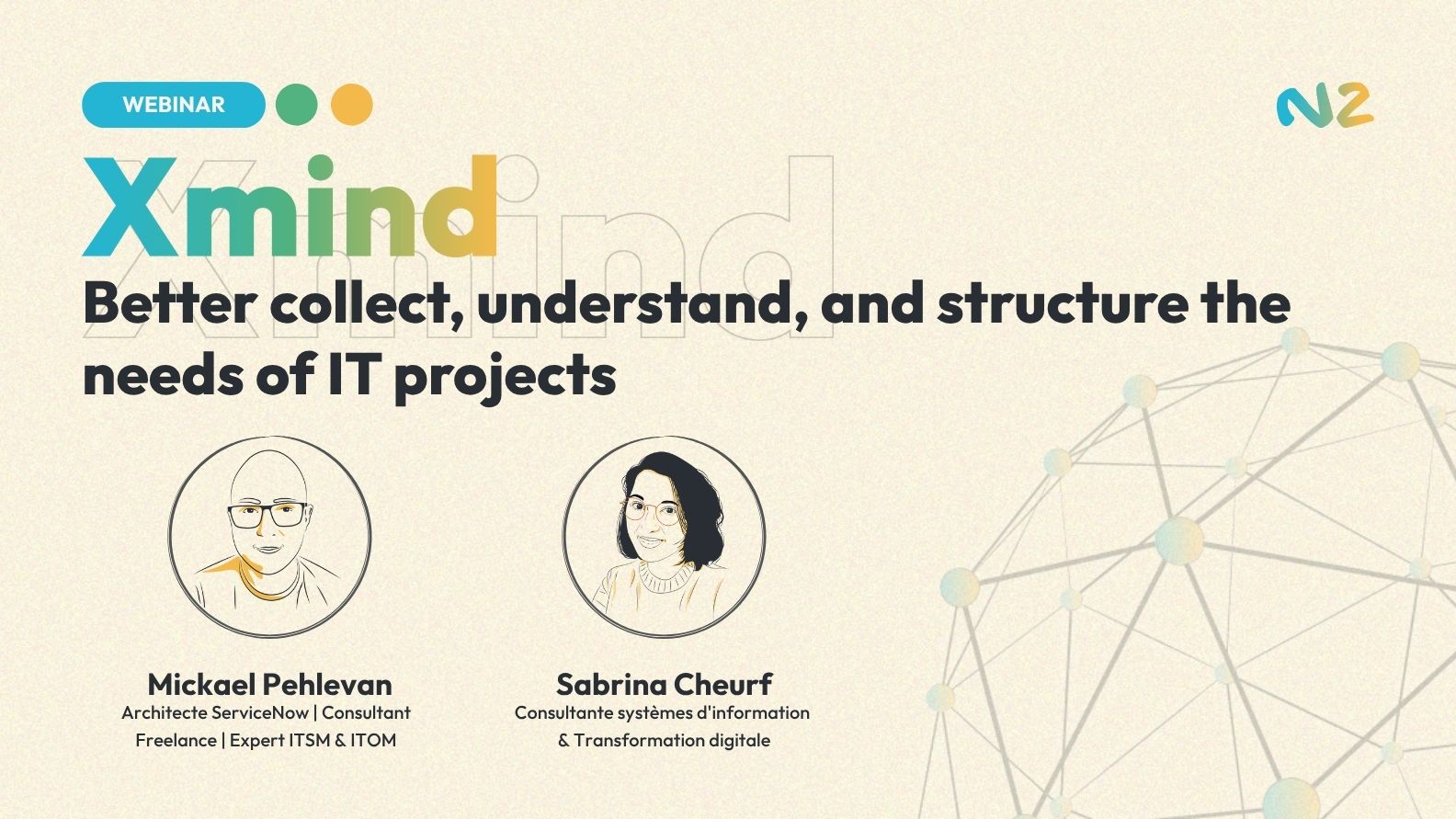This article is proposed by Mickaël Pelhevan, N2 player, Architecte ServiceNow | Consultant Freelance | Expert ITSM & ITOM.
In the world of IT projects, everyone swears they’re aligned… until you compare notes. One person talks about an “MVP,” another thinks “quick-win,” and a third understands “final delivery.” The result? Biased decisions, complex trade-offs, and PowerPoint slides that tell different stories depending on who’s in the room.
At the heart of this strategic cacophony, one truth emerges: it’s not about a lack of will, but rather a lack of common framework. A shared visual language that allows for divergence while enabling convergence. Enter Xmind, a powerful mind mapping software that transforms how we approach complex projects.
Why Clarity Becomes Priority Number One
In IT transformation projects where ServiceNow often plays a key role, we can’t afford to be vague. The stakes are too high. Misinterpreting a requirement can cost entire sprints, or even challenge investment decisions.
This is where the mind mapping approach, particularly with Xmind, comes into play. It’s not a magic wand, but a tool for radical clarification that brings out the unspoken, aligns visions, and puts thinking back at the center of project management. Xmind, available in both free and pro versions, offers a robust platform for idea visualization and strategic planning.
Xmind: An Antidote to IT Project Background Noise
A Visualization Tool That Speaks to Everyone
At first glance, Xmind appears to be a simple mind mapping application. But in the reality of IT projects, it quickly becomes a Swiss Army knife: from free brainstorming to detailed requirements structuring, through strategic formalization, it supports every stage with flexibility and power.
Unlike rigid tools like Excel or Jira (which certainly have their uses), Xmind offers a fluid expression space, without imposed hierarchy, where all ideas initially have equal value. And that changes everything. Whether you use Xmind online or the desktop version, you benefit from a powerful graphics engine to create impressive diagrams and mind maps.
Between Rigor and Freedom: A Rare Balance for Scoping
What sets Xmind apart is its ability to evolve at the pace of team thinking. You start with a blank page, no pressure. Then, as discussions progress, the map becomes denser: colors, groupings, icons, dependencies. Everything is there to move from informal to structured… without sacrificing agility.
It’s precisely this balance that makes it a strategic ally in complex contexts like ServiceNow: you can map a backlog, structure a multi-year roadmap, or formalize a security POC, without ever losing the thread or logic. Customizing maps with varied graphic palettes allows you to create beautiful mind maps tailored to each project.
Field Experience: How Xmind Transforms Our ServiceNow Projects
Business Context: Constantly Evolving Needs
At N2 Help & Solutions, we support clients dealing with IT projects that blend governance, security, automation, and strategic management. In these contexts, traditional tools quickly show their limits. Between business jargon, technical specifications, regulatory constraints, and top-down visions, communication becomes a headache.
With Xmind, we’ve found a way to make all these worlds communicate. Not by imposing formalism, but by creating a common space for reflection that serves both technical teams and decision-makers. Using predefined templates in Xmind accelerates the implementation of coherent information structures for different types of projects.
Requirements Gathering, Scoping, Decision-Making: Where Everything Happens
The early phases of a project are always critical. Poor requirement scoping means derailing everything that follows. By using Xmind from these initial stages, we’ve been able to:
- visualize friction points before they become problems,
- lay out implicit (and often divergent) MVPs,
- and document decisions with clear traceability.
This isn’t just drawing: it’s structured operational thinking in real-time. Real-time collaboration offered by Xmind allows teams to work together on a mind map, thus fostering a shared understanding of project stakes.
Case Study 1: Structuring a Multi-Year ITSM/ITOM Roadmap
Objective: Strategic Alignment
Imagine an organization in the midst of digital transformation, facing a myriad of ITSM and ITOM initiatives to plan over several years. Everyone wants to move forward, but no one really shares the same definition of priorities. Classic.
In this context, we used Xmind to build a visual roadmap covering several years (from 2023 to 2026). The idea was simple: establish a common and shared vision, clear for everyone, from the CIO to the project manager, including business stakeholders.
Method: From KGIs to KPIs via Xmind
The mind map was built in four stages:
- Free collection of needs, pain points, constraints, and expectations.
- Progressive structuring around global objectives (KGIs), critical success factors (CSFs), and key performance indicators (KPIs).
- Temporal projection, with milestones distributed by year.
- Collaborative framing validated by stakeholders.
Thanks to Xmind’s flexibility, each element was enriched with legends, priorities, maturity levels, and thematic tags. A true living dashboard, viewable at a glance, modifiable in real-time. Using Xmind’s icon library made the map more visual and intuitive.
Result: Accelerated Decision-Making, Reinforced Buy-In
The roadmap thus built enabled:
- rapid alignment between departments and teams,
- clear prioritization of strategic initiatives,
- accelerated scoping with fewer back-and-forths,
- and, crucially, better buy-in from top management thanks to impactful visual representation.
Case Study 2: Modeling a POC for Sensitive Incident Management
The Trap of Siloed Visions
In another project, the subject focused on managing particularly sensitive security incidents. Several teams were involved: ITSM, security, legal, governance… Needless to say, everyone had their own vision, needs, constraints, and especially, what the POC should contain.
The challenge? Build a common solution without freezing debates in 40-page Word documents. Spoiler: we used Xmind, the mind mapping software par excellence for this type of complex situation.
Segregation, Scope, Exclusion: Everything Becomes Visual
Thanks to a mind map structured by “sensitive zones,” each team could freely express their needs, concerns, and specificities. Xmind allowed us to:
- segment main, secondary, and excluded functionalities,
- map authorized roles and access restrictions,
- clarify the security incident lifecycle,
- and document the scopes covered or excluded from the POC.
Everything was visible, traceable, understandable by all. Even for non-technical people. Using Xmind’s ZEN mode allowed focus on specific sections of the map during presentations to different stakeholders.
Decide Faster, Without Bias or Ambiguity
The observed benefits?
- Less confusion about what was (or wasn’t) in scope,
- Faster decisions thanks to a clear and synthetic foundation,
- Better coordination between IT, security, and governance,
- And once again, reinforced management buy-in.
Cherry on top: the map served as support for a SWOT matrix comparing two options (in-house development vs. ServiceNow vendor solution). Result: better-informed decisions and better-targeted investments.
Case Study 3: Mapping an Automated Testing Strategy with ATF
Test Hierarchy: From Plan to Unit
On a quality-focused project, the objective was to build an automated testing strategy around ServiceNow’s ATF (Automated Test Framework) module. And once again, Xmind made all the difference.
The mind map allowed modeling of the three ATF levels:
- test plans,
- test cases,
- test steps.
Each level was organized according to the user journey, with a clear distinction between front-end (user portal) and back-office. Using Xmind’s timeline feature allowed clear visualization of test sequences.
Visualizing Critical Paths and Dependencies
Some actions could only be tested with specific prerequisites (e.g., an existing incident). Thanks to Xmind, it was easy to identify these dependencies, trace critical steps, and structure a progressive and coherent testing strategy.
The map also served to group test cases by functional theme (notifications, assignments, SLAs, reporting…), making their consultation and execution much clearer for QA and dev teams.
Reducing Regressions and Securing Sprints
At the end of the chain, the benefits were clear:
- time saved in sprint preparation,
- reduced risk of regression in production,
- a common discussion base between POs, testers, and developers,
- and a long-term vision of critical tests to maintain in each release.
Using Xmind in Workshops: Live-Mapping and Interactions
The Role of the Visual Scribe: Capturing Without Interpreting
We’re often asked: “Do you build Xmind maps live during workshops?” The answer is yes. And it’s often one of the most differentiating elements of our approach.
Concretely, while the facilitator leads discussions, one person plays the role of “visual scribe” and builds the mind map in real-time. This role is crucial. It allows:
- capturing ideas as they flow,
- structuring exchanges without freezing them,
- reformulating to validate collective understanding.
This creates a true mirror effect in the room: everyone sees the evolution of collective thinking in real-time. This approach is particularly effective for collaborative projects and group learning activities.
Validating Common Understanding in Real-Time
The magic happens when a participant raises their hand and says: “Wait, that’s not how I understood it…” This is where the mind map reveals its full power. It doesn’t replace discussion, it enriches it.
By visualizing links between ideas, making dependencies or contradictions explicit, Xmind becomes a catalyst for clarification. And most importantly, it allows validating decisions live, without waiting for a follow-up meeting or an approximate report.
Visual Prioritization Methods in Xmind
From Value/Effort Matrix to RICE
Once needs are established, they still need to be prioritized. Here too, Xmind proves remarkably effective.
Among the methods we use most often:
- The Value/Effort matrix: simple, visual, effective.
- The RICE method (Reach, Impact, Confidence, Effort), perfect for prioritizing in agile or product environments.
- Version milestones: V1, V2, V3, according to urgency and value.
What makes the difference? Visualizing these criteria directly in the map, via tags, colors, or labels. You’re not prioritizing in a cold spreadsheet, but in a space where each idea remains contextualized.
When and How to Involve Stakeholders?
Prioritization is too often done in silos. Yet it’s one of the most political and structuring moments of a project. That’s why we recommend doing it in a workshop, with the Xmind map projected on screen, with decision-makers around the table.
Result: decisions are more legitimate, better understood, and more stable over time. Even in case of disagreement, the map shows who said what, when, and why. Maximum transparency.
Tips and Best Practices for Useful and Elegant Maps
Colors, Legends, Tags: Effective Minimalism
You might think the more detailed a map, the better. Wrong. An overly dense map quickly becomes unreadable. The challenge is to maintain a good balance between richness and readability.
Here are some best practices we systematically apply:
- Use 3 to 4 colors maximum,
- Add icons to mark priority levels or statuses,
- Use legends and tags to group branches by theme,
- Create links between branches to make dependencies explicit.
Less is more. Especially when presenting to decision-makers. These principles apply whether you use Xmind in English or another language.
Version, Archive, Iterate: Xmind in Service of Agility
In long or evolving projects, it’s essential to be able to track the evolution of decisions. For this, we systematically version maps: V0.1, V0.2, V1.0, etc.
Each version is archived, allowing you to go back if needed, or trace the history of a decision. In workshops, this builds trust: we don’t erase ideas, we evolve them.
Finally, this approach also allows peaceful iteration. The map becomes a living space, not a frozen deliverable. And that changes everything in group dynamics.
Exporting and Reusing Your Maps: Xmind Beyond Brainstorming
From Mind Map to Business Deliverable
Xmind isn’t just a tool for workshops or Monday morning brainstorming. It quickly becomes a true documentation medium, useful in scoping, pre-sales, prioritization, or product strategy phases.
Thanks to export options (PDF, image, PowerPoint, Markdown…), you can easily integrate maps into:
- functional specifications,
- EPICs or user stories in Jira,
- Confluence pages,
- steering committee presentations.
In short: a well-built map can transform into a formal deliverable, without going through tedious copy-pasting. And it’s a real time-saver for consultants and clients alike.
Integration with Jira, Confluence, PowerPoint
We frequently use Xmind to structure maps that then become the foundation of a product backlog. Each branch is associated with a user story, sometimes even acceptance criteria. Relationships between branches help identify dependencies between tasks.
In PowerPoint, simply export certain branches as images to illustrate a topic in a steering meeting or prioritization workshop.
And in Confluence? A well-configured Markdown export provides a clear tree structure that can be enriched with textual explanations.
The Tool’s Limits and How to Work Around Them Intelligently
Too Much Info? Create Modular Branches
Xmind is powerful, but not magical. An overloaded map quickly becomes indigestible. The classic mistake: trying to say everything in one map.
Our advice: segment. One map per issue, one branch per target profile, a link to a dedicated sub-map if necessary. It’s a practice we often use to handle, for example, UX user journeys or distinct ITSM processes.
The trick is to modulate the map like you would modulate a speech: a main idea, clear sub-ideas, and appendices for those who want to go deeper.
Not Formal Enough? Combine Xmind and Traditional Documentation
Let’s be clear: Xmind doesn’t replace specifications, technical documentation, or a complete project plan. That’s not its role.
But it perfectly complements these deliverables by adding a visual and structuring layer that helps better understand issues, dependencies, and priorities. And most importantly, it makes content more accessible to non-technical audiences.
The right reflex: think complementarity. Xmind for scoping and visualizing, traditional documentation for formalizing and contracting.
Conclusion: Thinking Visually for Better Collective Decision-Making
What Xmind Really Changes in IT Projects
Xmind doesn’t solve all problems. But it makes them visible. And in the world of complex IT projects, that’s already huge.
Thanks to it, we can:
- defuse misunderstandings before they become conflicts,
- structure needs progressively and inclusively,
- align very different profiles around the same objective,
- and produce concrete materials for decision-making, deciding, and delivering.
Xmind’s real strength? It doesn’t replace collective intelligence, it makes it readable and shareable.
What’s Next? Toward Other Possible Business Uses
What we’ve explored here are three real use cases, but it’s just the beginning. Xmind can also be used to:
- structure a training plan,
- scope a call for tenders,
- model a product or service,
- or build a change management strategy.
In short: whenever there’s complexity, cross-functionality, and a need for clarity, Xmind can become a powerful ally.
FAQ – Xmind and Complex IT Project Management
A spreadsheet is perfect for managing lists and numbers, but it shows its limits when it comes to clarifying fuzzy ideas or requirements. Xmind allows you to visually structure information, connect ideas, and see dependencies at a glance. It’s the ideal tool for moving from initial chaos to a clear and shared vision of a complex IT project.
Yes, absolutely. Xmind allows easy iteration, user story prioritization, backlog visualization, and even sprint structuring. In agile or DevOps environments where decision speed is key, Xmind offers valuable flexibility to organize, clarify, and synchronize teams without rigidity.
Indirectly, yes. Xmind allows export in image, PDF, or Markdown format, which facilitates its integration into Jira (as attachments or Confluence documentation). Some branches can even serve as a basis for structuring an Epic or a series of user stories. It’s a good complement to these tools, especially for the upstream phase of projects.
The secret is modularity. It’s better to create several small maps linked together rather than a giant unreadable map. Use colors, tags, and hierarchical levels to organize information in a readable way, even for people discovering the project.
mind is particularly useful in: IT transformation projects (ITSM, ITOM); POC or MVP design; automated testing strategies (ATF); projects involving multiple stakeholders (security, legal, governance…); or requirements gathering and prioritization workshops. Whenever there’s complexity, multiple profiles, and a need for clarity, Xmind finds its full value.



